Are Animal And Plant Cells Eukaryotic Or Prokaryotic
Learning Objectives
- Explain the distinguishing characteristics of eukaryotic cells
- Describe internal and external structures of prokaryotic cells in terms of their physical structure, chemical structure, and function
- Identify and draw structures and organelles unique to eukaryotic cells
- Compare and contrast similar structures found in prokaryotic and eukaryotic cells
Eukaryotic organisms include protozoans, algae, fungi, plants, and animals. Some eukaryotic cells are independent, unmarried-celled microorganisms, whereas others are role of multicellular organisms. The cells of eukaryotic organisms accept several distinguishing characteristics. Above all, eukaryotic cells are defined by the presence of a nucleus surrounded by a complex nuclear membrane. Also, eukaryotic cells are characterized by the presence of membrane-bound organelles in the cytoplasm. Organelles such every bit mitochondria, the endoplasmic reticulum (ER), Golgi apparatus, lysosomes, and peroxisomes are held in place past the cytoskeleton, an internal network that supports transport of intracellular components and helps maintain cell shape (Figure 1). The genome of eukaryotic cells is packaged in multiple, rod-shaped chromosomes as opposed to the single, circular-shaped chromosome that characterizes almost prokaryotic cells. Table 1 compares the characteristics of eukaryotic cell structures with those of bacteria and archaea.
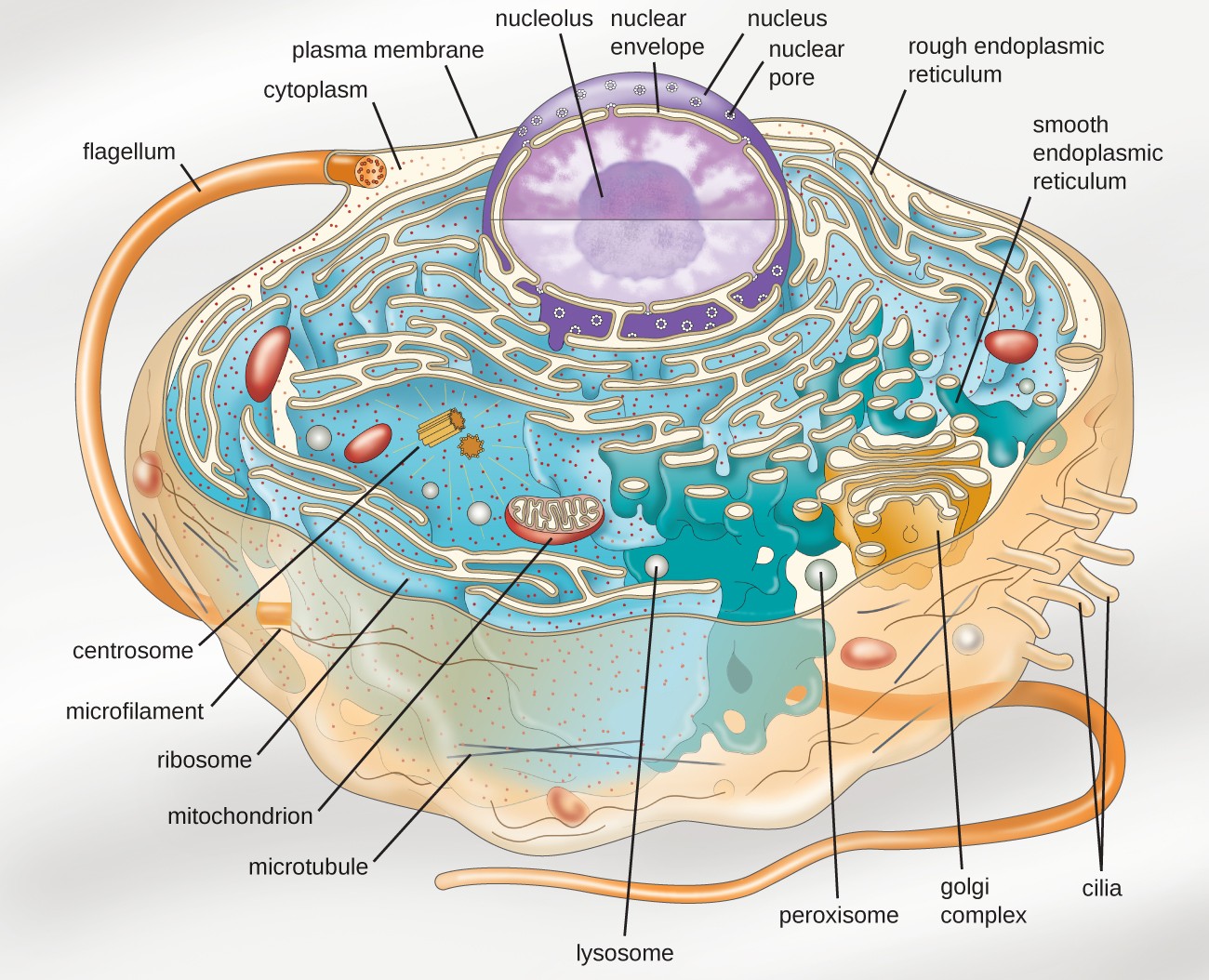 Figure i. Click for a larger epitome. An illustration of a generalized, single-celled eukaryotic organism. Notation that cells of eukaryotic organisms vary greatly in terms of construction and function, and a particular jail cell may not accept all of the structures shown here.
Figure i. Click for a larger epitome. An illustration of a generalized, single-celled eukaryotic organism. Notation that cells of eukaryotic organisms vary greatly in terms of construction and function, and a particular jail cell may not accept all of the structures shown here.
| Table 1. Summary of Cell Structures | |||
|---|---|---|---|
| Cell Structure | Prokaryotes | Eukaryotes | |
| Bacteria | Archaea | ||
| Size | ~0.5–1 μM | ~0.5–1 μM | ~5–xx μM |
| Surface expanse-to-volume ratio | High | High | Depression |
| Nucleus | No | No | Yes |
| Genome characteristics |
|
|
|
| Prison cell partition | Binary fission | Binary fission | Mitosis, meiosis |
| Membrane lipid composition |
|
|
|
| Cell wall composition |
|
|
|
| Motility structures | Rigid spiral flagella composed of flagellin | Rigid spiral flagella composed of archaeal flagellins | Flexible flagella and cilia composed of microtubules |
| Membrane-bound organelles | No | No | Yes |
| Endomembrane organization | No | No | Yes (ER, Golgi, lysosomes) |
| Ribosomes | 70S | 70S |
|
Jail cell Morphologies
Eukaryotic cells display a wide variety of different cell morphologies. Possible shapes include spheroid, ovoid, cuboidal, cylindrical, flat, lenticular, fusiform, discoidal, crescent, ring stellate, and polygonal (Effigy 2). Some eukaryotic cells are irregular in shape, and some are capable of changing shape. The shape of a particular type of eukaryotic cell may be influenced by factors such equally its primary function, the organization of its cytoskeleton, the viscosity of its cytoplasm, the rigidity of its cell membrane or cell wall (if it has i), and the physical pressure exerted on information technology by the surrounding environment and/or adjoining cells.
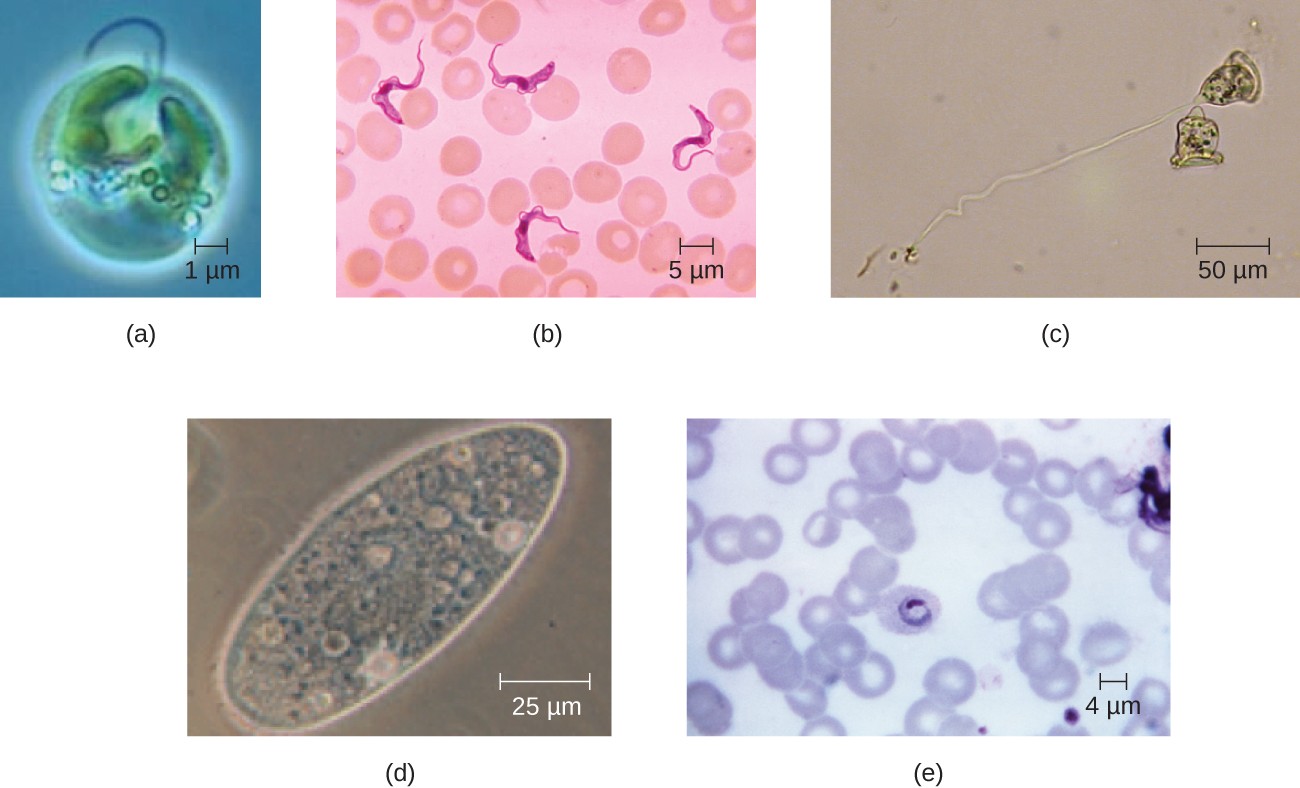 Effigy 2. Eukaryotic cells come up in a variety of jail cell shapes. (a) Spheroid Chromulina alga. (b) Fusiform shaped Trypanosoma. (c) Bell-shaped Vorticella. (d) Ovoid Paramecium. (e) Ring-shaped Plasmodium ovale. (credit a: modification of work by NOAA; credit b, e: modification of work by Centers for Affliction Command and Prevention)
Effigy 2. Eukaryotic cells come up in a variety of jail cell shapes. (a) Spheroid Chromulina alga. (b) Fusiform shaped Trypanosoma. (c) Bell-shaped Vorticella. (d) Ovoid Paramecium. (e) Ring-shaped Plasmodium ovale. (credit a: modification of work by NOAA; credit b, e: modification of work by Centers for Affliction Command and Prevention)
Retrieve about It
- Place two differences between eukaryotic and prokaryotic cells.
Nucleus
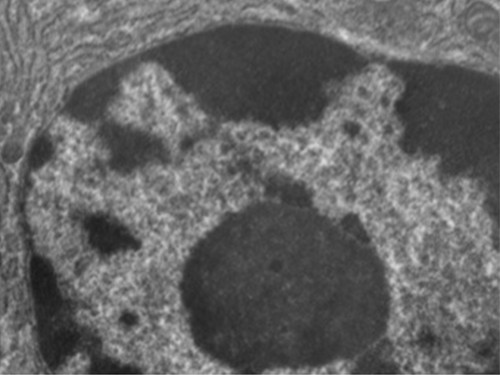 Figure 3. Eukaryotic cells have a well-divers nucleus. The nucleus of this mammalian lung cell is the large, dark, oval-shaped structure in the lower one-half of the image.
Figure 3. Eukaryotic cells have a well-divers nucleus. The nucleus of this mammalian lung cell is the large, dark, oval-shaped structure in the lower one-half of the image.
Dissimilar prokaryotic cells, in which Dna is loosely independent in the nucleoid region, eukaryotic cells possess a nucleus, which is surrounded by a complex nuclear membrane that houses the DNA genome (Figure 3). By containing the cell's Dna, the nucleus ultimately controls all activities of the cell and too serves an essential role in reproduction and heredity. Eukaryotic cells typically have their DNA organized into multiple linear chromosomes. The Deoxyribonucleic acid within the nucleus is highly organized and condensed to fit inside the nucleus, which is achieved by wrapping the Dna around proteins called histones.
Although well-nigh eukaryotic cells have only one nucleus, exceptions exist. For case, protozoans of the genus Paramecium typically accept two complete nuclei: a small nucleus that is used for reproduction (micronucleus) and a large nucleus that directs cellular metabolism (macronucleus). Additionally, some fungi transiently class cells with ii nuclei, called heterokaryotic cells, during sexual reproduction. Cells whose nuclei divide, but whose cytoplasm does not, are called coenocytes.
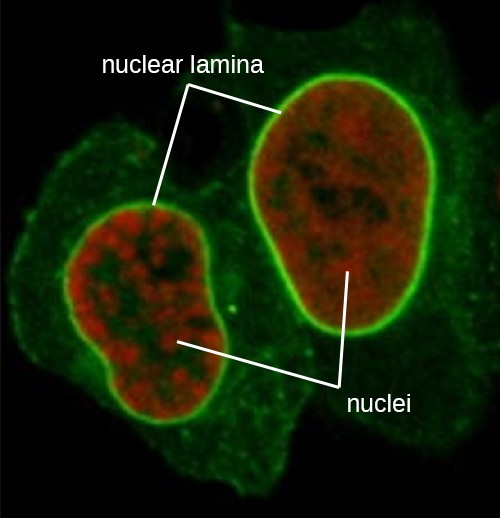 Effigy iv. In this fluorescent microscope image, all the intermediate filaments have been stained with a bright dark-green fluorescent stain. The nuclear lamina is the intense bright green ring effectually the faint ruddy nuclei.
Effigy iv. In this fluorescent microscope image, all the intermediate filaments have been stained with a bright dark-green fluorescent stain. The nuclear lamina is the intense bright green ring effectually the faint ruddy nuclei.
The nucleus is bound by a complex nuclear membrane, often called the nuclear envelope, that consists of 2 distinct lipid bilayers that are contiguous with each other (Figure 4). Despite these connections between the inner and outer membranes, each membrane contains unique lipids and proteins on its inner and outer surfaces. The nuclear envelope contains nuclear pores, which are big, rosette-shaped protein complexes that control the movement of materials into and out of the nucleus. The overall shape of the nucleus is determined by the nuclear lamina, a meshwork of intermediate filaments plant merely inside the nuclear envelope membranes. Exterior the nucleus, additional intermediate filaments form a looser mesh and serve to anchor the nucleus in position within the jail cell.
Nucleolus
The nucleolus is a dumbo region inside the nucleus where ribosomal RNA (rRNA) biosynthesis occurs. In addition, the nucleolus is as well the site where associates of ribosomes begins. Preribosomal complexes are assembled from rRNA and proteins in the nucleolus; they are and then transported out to the cytoplasm, where ribosome assembly is completed (Figure 5).
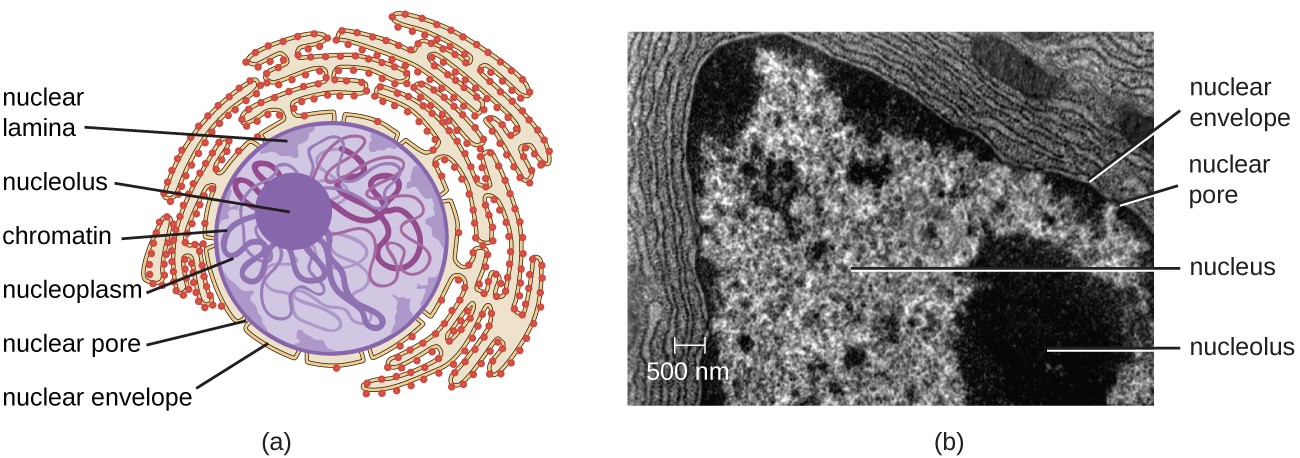 Figure 5. (a) The nucleolus is the dark, dense area within the nucleus. It is the site of rRNA synthesis and preribosomal assembly. (b) Electron micrograph showing the nucleolus.
Figure 5. (a) The nucleolus is the dark, dense area within the nucleus. It is the site of rRNA synthesis and preribosomal assembly. (b) Electron micrograph showing the nucleolus.
Ribosomes
Ribosomes found in eukaryotic organelles such as mitochondria or chloroplasts have 70S ribosomes—the same size every bit prokaryotic ribosomes. However, nonorganelle-associated ribosomes in eukaryotic cells are 80S ribosomes, composed of a 40S small subunit and a 60S big subunit. In terms of size and composition, this makes them distinct from the ribosomes of prokaryotic cells.
The 2 types of nonorganelle-associated eukaryotic ribosomes are defined past their location in the cell: costless ribosomes and membrane-bound ribosomes. Gratis ribosomes are plant in the cytoplasm and serve to synthesize water-soluble proteins; membrane-bound ribosomes are found attached to the rough endoplasmic reticulum and brand proteins for insertion into the prison cell membrane or proteins destined for export from the jail cell.
The differences between eukaryotic and prokaryotic ribosomes are clinically relevant because certain antibody drugs are designed to target i or the other. For example, cycloheximide targets eukaryotic activeness, whereas chloramphenicol targets prokaryotic ribosomes.[vii] Since human cells are eukaryotic, they mostly are not harmed by antibiotics that destroy the prokaryotic ribosomes in bacteria. Even so, sometimes negative side effects may occur considering mitochondria in human cells contain prokaryotic ribosomes.
Endomembrane Organization
The endomembrane arrangement, unique to eukaryotic cells, is a serial of membranous tubules, sacs, and flattened disks that synthesize many cell components and move materials around within the jail cell (Figure half-dozen). Because of their larger cell size, eukaryotic cells crave this system to transport materials that cannot be dispersed past diffusion alone. The endomembrane system comprises several organelles and connections betwixt them, including the endoplasmic reticulum, Golgi apparatus, lysosomes, and vesicles.
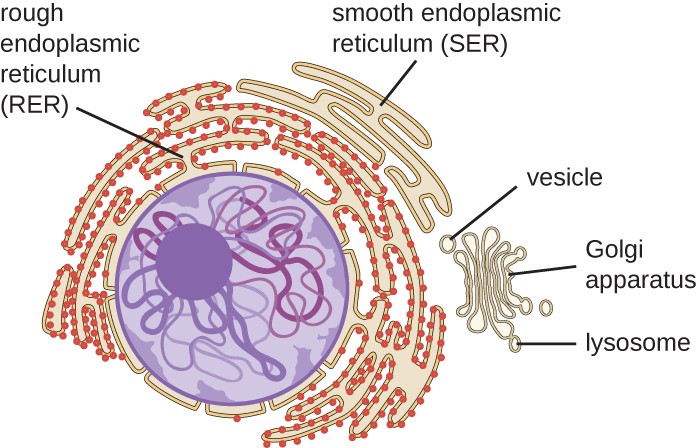 Figure half dozen. The endomembrane arrangement is composed of a series of membranous intracellular structures that facilitate motility of materials throughout the cell and to the jail cell membrane.
Figure half dozen. The endomembrane arrangement is composed of a series of membranous intracellular structures that facilitate motility of materials throughout the cell and to the jail cell membrane.
Endoplasmic Reticulum
The endoplasmic reticulum (ER) is an interconnected assortment of tubules and cisternae (flattened sacs) with a single lipid bilayer (Figure seven). The spaces within of the cisternae are called lumen of the ER. There are 2 types of ER, crude endoplasmic reticulum (RER) and smooth endoplasmic reticulum (SER). These ii unlike types of ER are sites for the synthesis of distinctly different types of molecules. RER is studded with ribosomes bound on the cytoplasmic side of the membrane. These ribosomes make proteins destined for the plasma membrane (Figure 7). Following synthesis, these proteins are inserted into the membrane of the RER. Modest sacs of the RER containing these newly synthesized proteins and so bud off as transport vesicles and move either to the Golgi apparatus for further processing, straight to the plasma membrane, to the membrane of another organelle, or out of the cell. Ship vesicles are single-lipid, bilayer, bleary spheres with hollow interiors that bear molecules. SER does non have ribosomes and, therefore, appears "smooth." It is involved in biosynthesis of lipids, carbohydrate metabolism, and detoxification of toxic compounds inside the cell.
 Figure 7. The crude endoplasmic reticulum is studded with ribosomes for the synthesis of membrane proteins (which give it its rough appearance).
Figure 7. The crude endoplasmic reticulum is studded with ribosomes for the synthesis of membrane proteins (which give it its rough appearance).
Golgi Apparatus
The Golgi apparatus was discovered within the endomembrane system in 1898 past Italian scientist Camillo Golgi (1843–1926), who developed a novel staining technique that showed stacked membrane structures inside the cells of Plasmodium, the causative agent of malaria. The Golgi apparatus is equanimous of a series of membranous disks called dictyosomes, each having a single lipid bilayer, that are stacked together (Figure 8).
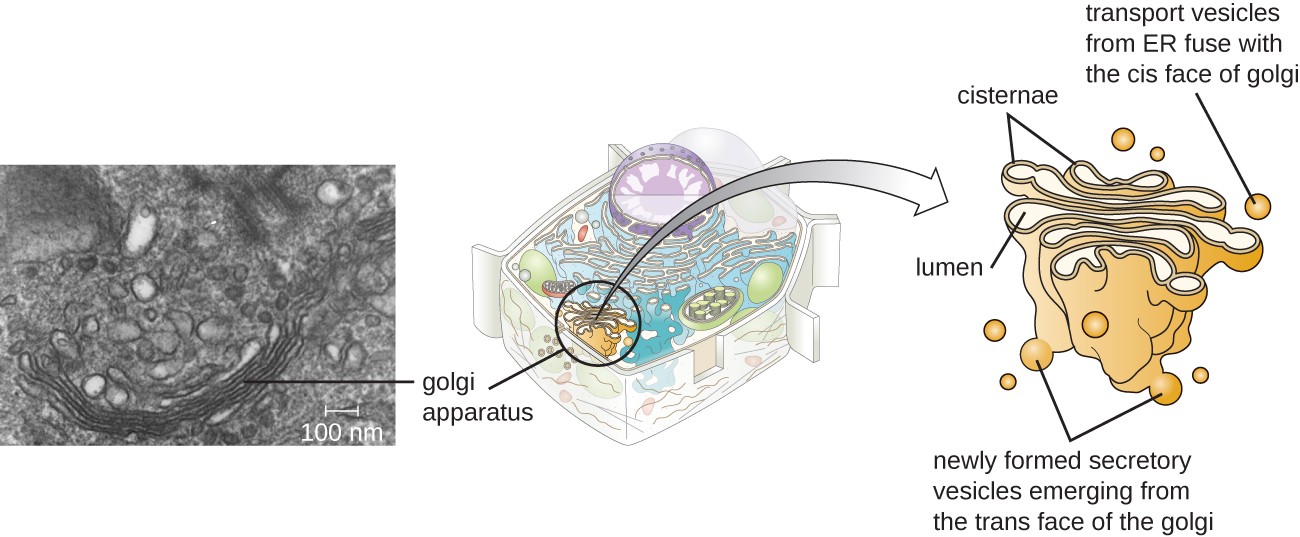 Figure 8. A transmission electron micrograph (left) of a Golgi apparatus in a white blood cell. The illustration (correct) shows the cup-shaped, stacked disks and several transport vesicles. The Golgi appliance modifies lipids and proteins, producing glycolipids and glycoproteins, respectively, which are commonly inserted into the plasma membrane.
Figure 8. A transmission electron micrograph (left) of a Golgi apparatus in a white blood cell. The illustration (correct) shows the cup-shaped, stacked disks and several transport vesicles. The Golgi appliance modifies lipids and proteins, producing glycolipids and glycoproteins, respectively, which are commonly inserted into the plasma membrane.
Enzymes in the Golgi apparatus modify lipids and proteins transported from the ER to the Golgi, frequently adding carbohydrate components to them, producing glycolipids, glycoproteins, or proteoglycans. Glycolipids and glycoproteins are often inserted into the plasma membrane and are important for signal recognition past other cells or infectious particles. Different types of cells can exist distinguished from ane another by the structure and arrangement of the glycolipids and glycoproteins contained in their plasma membranes. These glycolipids and glycoproteins unremarkably as well serve as cell surface receptors.
Transport vesicles leaving the ER fuse with a Golgi appliance on its receiving, or cis, face. The proteins are processed within the Golgi appliance, and then additional ship vesicles containing the modified proteins and lipids pinch off from the Golgi appliance on its outgoing, or trans, confront. These approachable vesicles move to and fuse with the plasma membrane or the membrane of other organelles.
Exocytosis is the process by which secretory vesicles (spherical bleary sacs) release their contents to the cell's exterior (Figure 8). All cells have constitutive secretory pathways in which secretory vesicles transport soluble proteins that are released from the jail cell continually (constitutively). Certain specialized cells too take regulated secretory pathways, which are used to store soluble proteins in secretory vesicles. Regulated secretion involves substances that are only released in response to certain events or signals. For example, certain cells of the man immune system (east.g., mast cells) secrete histamine in response to the presence of foreign objects or pathogens in the body. Histamine is a compound that triggers various mechanisms used past the allowed system to eliminate pathogens.
Lysosomes
In the 1960s, Belgian scientist Christian de Duve (1917–2013) discovered lysosomes, membrane-leap organelles of the endomembrane system that contain digestive enzymes. Certain types of eukaryotic cells use lysosomes to break downward various particles, such every bit food, damaged organelles or cellular debris, microorganisms, or immune complexes. Compartmentalization of the digestive enzymes within the lysosome allows the cell to efficiently digest affair without harming the cytoplasmic components of the cell.
Think near It
- Name the components of the endomembrane organisation and describe the role of each component.
Peroxisomes
Christian de Duve is likewise credited with the discovery of peroxisomes, membrane-bound organelles that are not part of the endomembrane organisation (Figure 9). Peroxisomes form independently in the cytoplasm from the synthesis of peroxin proteins by free ribosomes and the incorporation of these peroxin proteins into existing peroxisomes. Growing peroxisomes then divide past a process similar to binary fission.
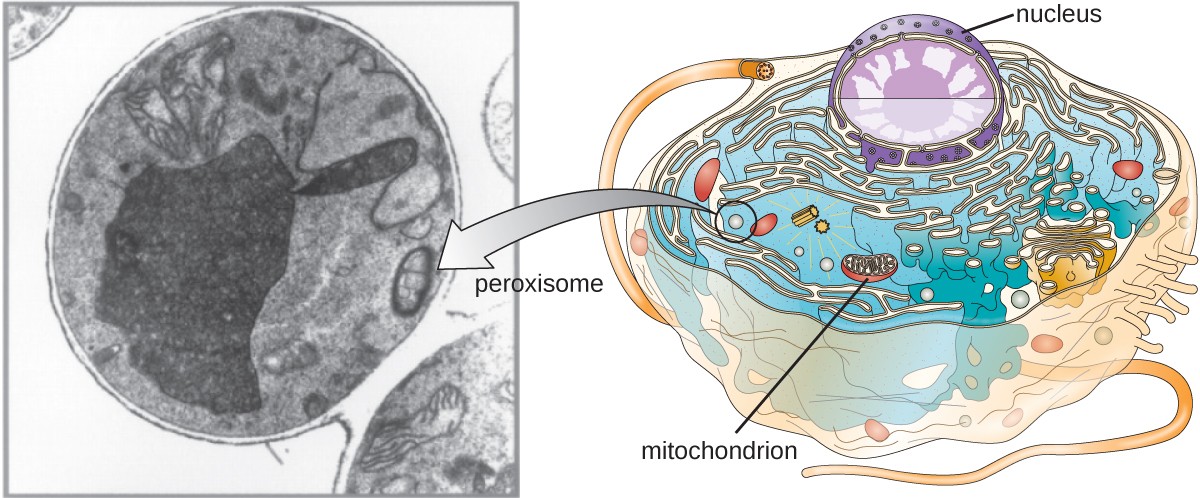 Figure ix. A transmission electron micrograph (left) of a cell containing a peroxisome. The illustration (right) shows the location of peroxisomes in a cell. These eukaryotic structures play a part in lipid biosynthesis and breaking down various molecules. They may too accept other specialized functions depending on the cell blazon. (credit "micrograph": modification of work past American Society for Microbiology)
Figure ix. A transmission electron micrograph (left) of a cell containing a peroxisome. The illustration (right) shows the location of peroxisomes in a cell. These eukaryotic structures play a part in lipid biosynthesis and breaking down various molecules. They may too accept other specialized functions depending on the cell blazon. (credit "micrograph": modification of work past American Society for Microbiology)
Peroxisomes were starting time named for their ability to produce hydrogen peroxide, a highly reactive molecule that helps to break down molecules such as uric acid, amino acids, and fatty acids. Peroxisomes also possess the enzyme catalase, which tin degrade hydrogen peroxide. Along with the SER, peroxisomes also play a role in lipid biosynthesis. Like lysosomes, the compartmentalization of these degradative molecules inside an organelle helps protect the cytoplasmic contents from unwanted damage.
The peroxisomes of certain organisms are specialized to see their particular functional needs. For example, glyoxysomes are modified peroxisomes of yeasts and plant cells that perform several metabolic functions, including the product of sugar molecules. Similarly, glycosomes are modified peroxisomes fabricated by sure trypanosomes, the pathogenic protozoans that crusade Chagas affliction and African sleeping sickness.
Cytoskeleton
Eukaryotic cells have an internal cytoskeleton made of microfilaments, intermediate filaments, and microtubules. This matrix of fibers and tubes provides structural support as well as a network over which materials can be transported inside the cell and on which organelles can exist anchored (Effigy ten). For example, the procedure of exocytosis involves the move of a vesicle via the cytoskeletal network to the plasma membrane, where it tin release its contents.
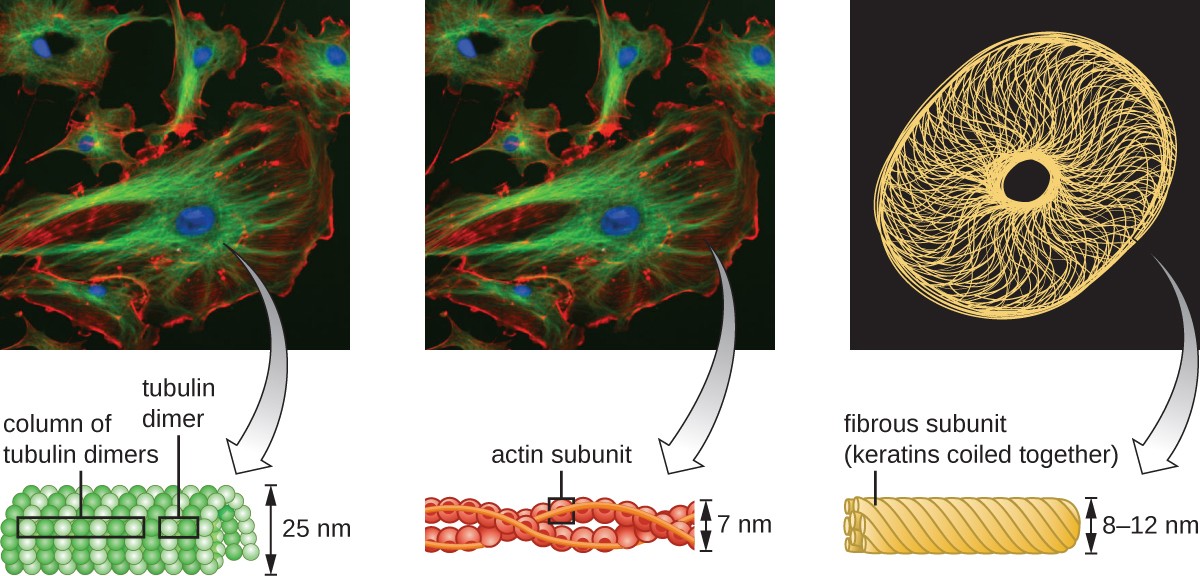 Figure 10. The cytoskeleton is a network of microfilaments, intermediate filaments, and microtubules constitute throughout the cytoplasm of a eukaryotic cell. In these fluorescently labeled animal cells, the microtubules are greenish, the actin microfilaments are red, the nucleus is bluish, and keratin (a type of intermediate filament) is xanthous.
Figure 10. The cytoskeleton is a network of microfilaments, intermediate filaments, and microtubules constitute throughout the cytoplasm of a eukaryotic cell. In these fluorescently labeled animal cells, the microtubules are greenish, the actin microfilaments are red, the nucleus is bluish, and keratin (a type of intermediate filament) is xanthous.
Microfilaments are composed of 2 intertwined strands of actin, each equanimous of actin monomers forming filamentous cables 6 nm in diameter[8] (Figure 11). The actin filaments work together with motor proteins, like myosin, to effect muscle contraction in animals or the amoeboid movement of some eukaryotic microbes. In ameboid organisms, actin can exist found in two forms: a stiffer, polymerized, gel form and a more than fluid, unpolymerized soluble form. Actin in the gel form creates stability in the ectoplasm, the gel-like area of cytoplasm just inside the plasma membrane of ameboid protozoans.
Temporary extensions of the cytoplasmic membrane called pseudopodia (pregnant "false feet") are produced through the forward flow of soluble actin filaments into the pseudopodia, followed past the gel-sol cycling of the actin filaments, resulting in cell motility. In one case the cytoplasm extends outward, forming a pseudopodium, the remaining cytoplasm flows upward to join the leading edge, thereby creating forward locomotion. Beyond amoeboid motion, microfilaments are also involved in a multifariousness of other processes in eukaryotic cells, including cytoplasmic streaming (the motion or circulation of cytoplasm within the prison cell), cleavage furrow formation during cell division, and muscle movement in animals (Figure 11). These functions are the result of the dynamic nature of microfilaments, which can polymerize and depolymerize relatively easily in response to cellular signals, and their interactions with molecular motors in dissimilar types of eukaryotic cells.
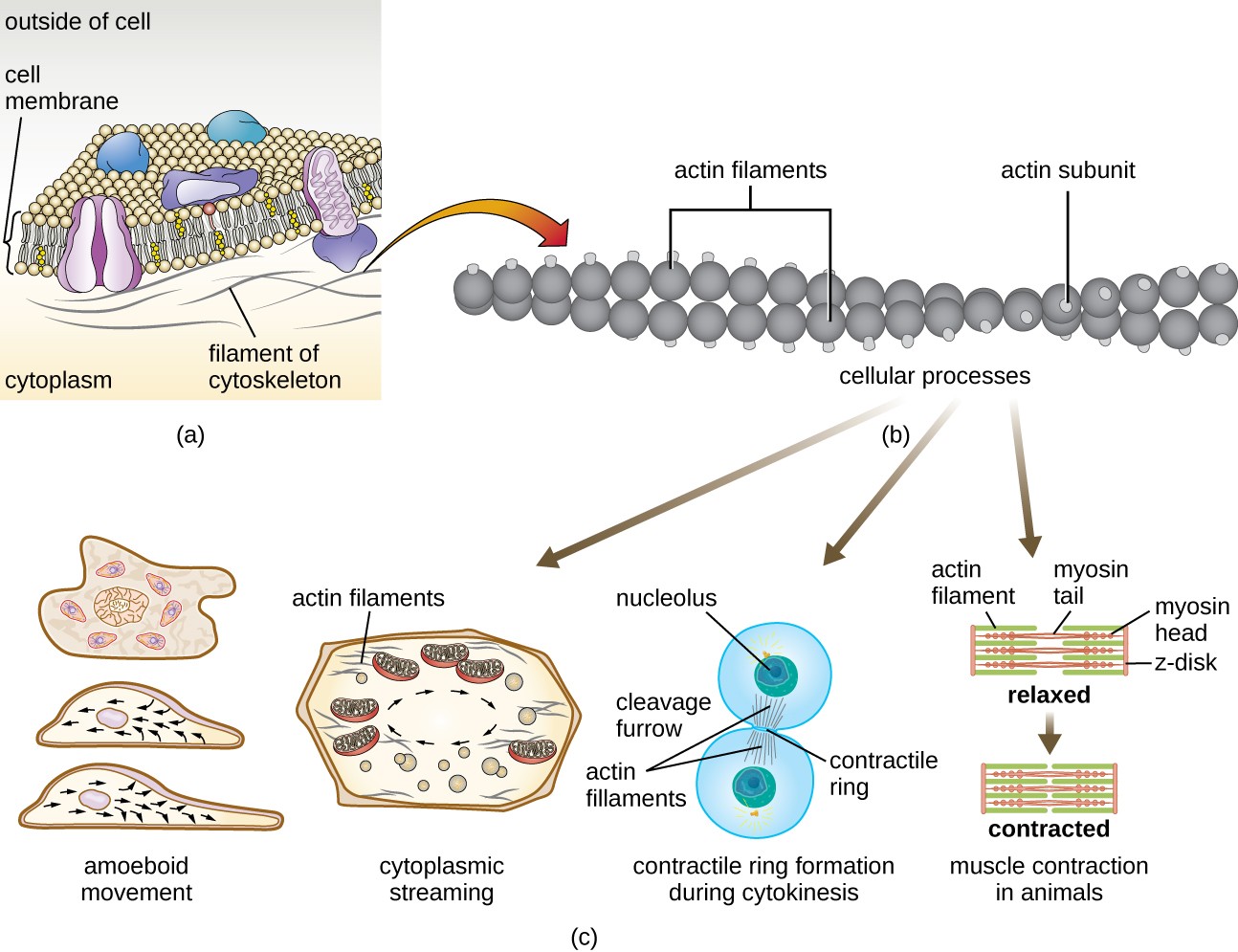 Figure eleven. (a) A microfilament is equanimous of a pair of actin filaments. (b) Each actin filament is a string of polymerized actin monomers. (c) The dynamic nature of actin, due to its polymerization and depolymerization and its association with myosin, allows microfilaments to be involved in a variety of cellular processes, including ameboid movement, cytoplasmic streaming, contractile band formation during cell sectionalization, and muscle contraction in animals.
Figure eleven. (a) A microfilament is equanimous of a pair of actin filaments. (b) Each actin filament is a string of polymerized actin monomers. (c) The dynamic nature of actin, due to its polymerization and depolymerization and its association with myosin, allows microfilaments to be involved in a variety of cellular processes, including ameboid movement, cytoplasmic streaming, contractile band formation during cell sectionalization, and muscle contraction in animals.
Intermediate filaments (Figure 12) are a diverse group of cytoskeletal filaments that act as cables inside the jail cell. They are termed "intermediate" because their x-nm diameter is thicker than that of actin but thinner than that of microtubules.[9] They are equanimous of several strands of polymerized subunits that, in plough, are made up of a wide variety of monomers. Intermediate filaments tend to be more permanent in the jail cell and maintain the position of the nucleus. They likewise class the nuclear lamina (lining or layer) just within the nuclear envelope. Additionally, intermediate filaments play a role in anchoring cells together in animate being tissues. The intermediate filament poly peptide desmin is found in desmosomes, the protein structures that bring together muscle cells together and help them resist external physical forces. The intermediate filament protein keratin is a structural protein plant in hair, skin, and nails.
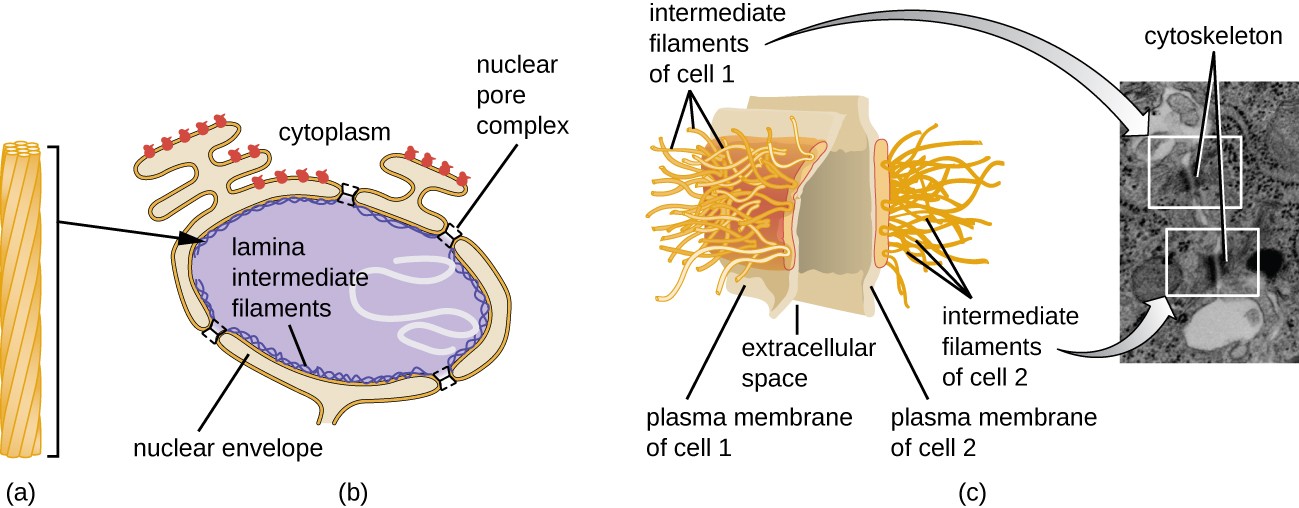 Effigy 12. (a) Intermediate filaments are equanimous of multiple strands of polymerized subunits. They are more permanent than other cytoskeletal structures and serve a variety of functions. (b) Intermediate filaments grade much of the nuclear lamina. (c) Intermediate filaments form the desmosomes between cells in some creature tissues. (credit c "illustration": modification of work past Mariana Ruiz Villareal)
Effigy 12. (a) Intermediate filaments are equanimous of multiple strands of polymerized subunits. They are more permanent than other cytoskeletal structures and serve a variety of functions. (b) Intermediate filaments grade much of the nuclear lamina. (c) Intermediate filaments form the desmosomes between cells in some creature tissues. (credit c "illustration": modification of work past Mariana Ruiz Villareal)
Microtubules (Figure 13) are a third type of cytoskeletal fiber equanimous of tubulin dimers (α tubulin and β tubulin). These form hollow tubes 23 nm in diameter that are used as girders inside the cytoskeleton.[10] Like microfilaments, microtubules are dynamic and have the ability to apace assemble and disassemble. Microtubules as well work with motor proteins (such as dynein and kinesin) to movement organelles and vesicles around within the cytoplasm. Additionally, microtubules are the master components of eukaryotic flagella and cilia, composing both the filament and the basal trunk components (Figure xx).
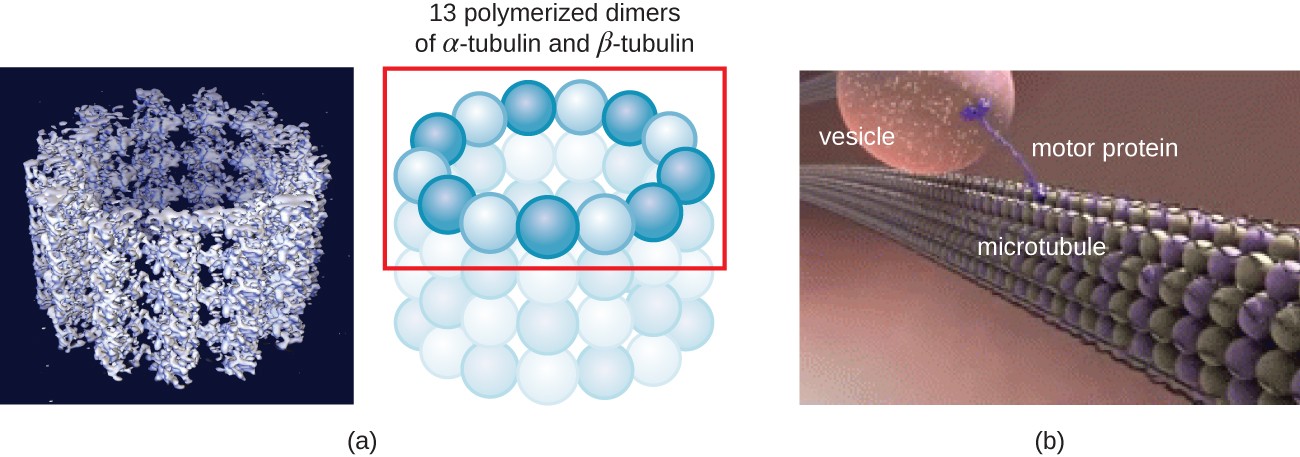 Figure 13. (a) Microtubules are hollow structures composed of polymerized tubulin dimers. (b) They are involved in several cellular processes, including the move of organelles throughout the cytoplasm. Motor proteins carry organelles along microtubule tracks that crisscross the entire cell. (credit b: modification of work by National Institute on Aging)
Figure 13. (a) Microtubules are hollow structures composed of polymerized tubulin dimers. (b) They are involved in several cellular processes, including the move of organelles throughout the cytoplasm. Motor proteins carry organelles along microtubule tracks that crisscross the entire cell. (credit b: modification of work by National Institute on Aging)
In addition, microtubules are involved in prison cell division, forming the mitotic spindle that serves to separate chromosomes during mitosis and meiosis. The mitotic spindle is produced by 2 centrosomes, which are essentially microtubule-organizing centers, at opposite ends of the jail cell. Each centrosome is equanimous of a pair of centrioles positioned at right angles to each other, and each centriole is an array of 9 parallel microtubules arranged in triplets (Figure fourteen).
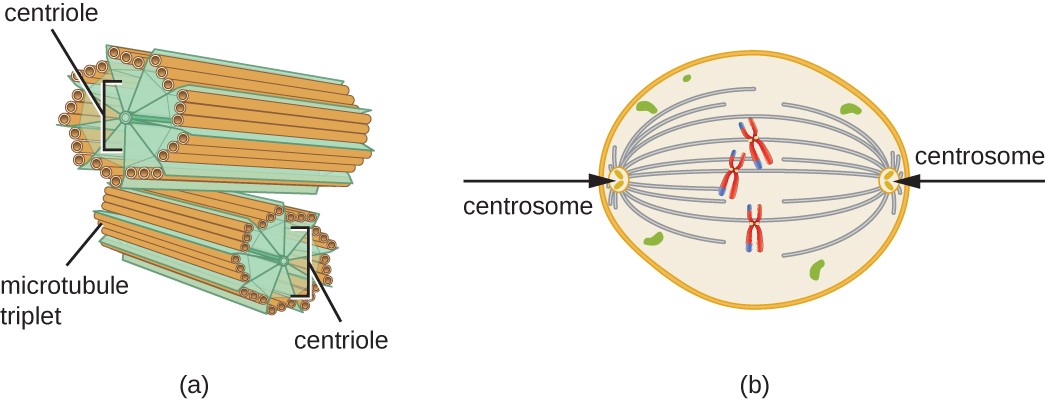 Figure 14. (a) A centrosome is composed of 2 centrioles positioned at right angles to each other. Each centriole is equanimous of nine triplets of microtubules held together by accessory proteins. (b) In animal cells, the centrosomes (arrows) serve as microtubule-organizing centers of the mitotic spindle during mitosis.
Figure 14. (a) A centrosome is composed of 2 centrioles positioned at right angles to each other. Each centriole is equanimous of nine triplets of microtubules held together by accessory proteins. (b) In animal cells, the centrosomes (arrows) serve as microtubule-organizing centers of the mitotic spindle during mitosis.
Recollect most It
- Compare and contrast the 3 types of cytoskeletal structures described in this section.
Mitochondria
The big, complex organelles in which aerobic cellular respiration occurs in eukaryotic cells are called mitochondria (Figure 15). The term "mitochondrion" was get-go coined by German language microbiologist Carl Benda in 1898 and was later connected with the process of respiration past Otto Warburg in 1913. Scientists during the 1960s discovered that mitochondria have their own genome and 70S ribosomes. The mitochondrial genome was found to be bacterial, when it was sequenced in 1976. These findings ultimately supported the endosymbiotic theory proposed by Lynn Margulis, which states that mitochondria originally arose through an endosymbiotic upshot in which a bacterium capable of aerobic cellular respiration was taken upwards by phagocytosis into a host cell and remained as a viable intracellular component.
Each mitochondrion has 2 lipid membranes. The outer membrane is a remnant of the original host cell'south membrane structures. The inner membrane was derived from the bacterial plasma membrane. The electron transport chain for aerobic respiration uses integral proteins embedded in the inner membrane. The mitochondrial matrix, corresponding to the location of the original bacterium's cytoplasm, is the electric current location of many metabolic enzymes. It likewise contains mitochondrial Deoxyribonucleic acid and 70S ribosomes. Invaginations of the inner membrane, called cristae, evolved to increase surface area for the location of biochemical reactions. The folding patterns of the cristae differ among diverse types of eukaryotic cells and are used to distinguish different eukaryotic organisms from each other.
 Figure xv. Each mitochondrion is surrounded past 2 membranes, the inner of which is extensively folded into cristae and is the site of the intermembrane infinite. The mitochondrial matrix contains the mitochondrial Dna, ribosomes, and metabolic enzymes. The transmission electron micrograph of a mitochondrion, on the correct, shows both membranes, including cristae and the mitochondrial matrix. (credit "micrograph": modification of work by Matthew Britton; scale-bar data from Matt Russell)
Figure xv. Each mitochondrion is surrounded past 2 membranes, the inner of which is extensively folded into cristae and is the site of the intermembrane infinite. The mitochondrial matrix contains the mitochondrial Dna, ribosomes, and metabolic enzymes. The transmission electron micrograph of a mitochondrion, on the correct, shows both membranes, including cristae and the mitochondrial matrix. (credit "micrograph": modification of work by Matthew Britton; scale-bar data from Matt Russell)
Chloroplasts
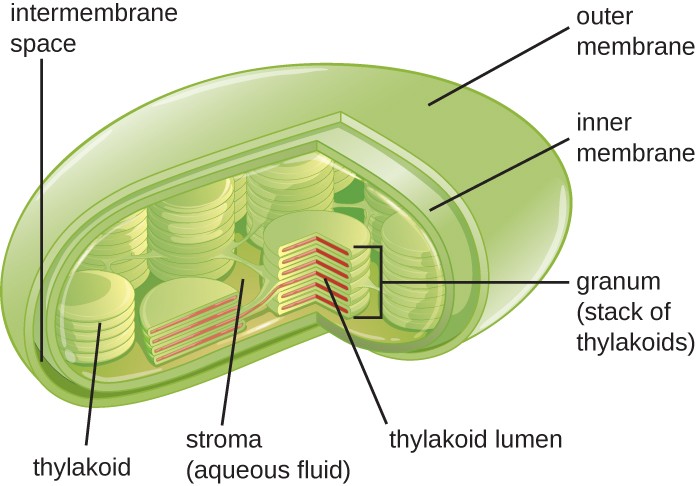 Figure 16. Photosynthesis takes place in chloroplasts, which take an outer membrane and an inner membrane. Stacks of thylakoids chosen grana course a third membrane layer.
Figure 16. Photosynthesis takes place in chloroplasts, which take an outer membrane and an inner membrane. Stacks of thylakoids chosen grana course a third membrane layer.
Found cells and algal cells contain chloroplasts, the organelles in which photosynthesis occurs (Figure 16). All chloroplasts take at least iii membrane systems: the outer membrane, the inner membrane, and the thylakoid membrane arrangement. Within the outer and inner membranes is the chloroplast stroma, a gel-like fluid that makes up much of a chloroplast's volume, and in which the thylakoid organisation floats. The thylakoid system is a highly dynamic collection of folded membrane sacs. Information technology is where the green photosynthetic pigment chlorophyll is establish and the low-cal reactions of photosynthesis occur. In most plant chloroplasts, the thylakoids are bundled in stacks called grana (singular: granum), whereas in some algal chloroplasts, the thylakoids are gratis floating.
Other organelles like to mitochondria have arisen in other types of eukaryotes, only their roles differ. Hydrogenosomes are found in some anaerobic eukaryotes and serve as the location of anaerobic hydrogen production. Hydrogenosomes typically lack their own Deoxyribonucleic acid and ribosomes. Kinetoplasts are a variation of the mitochondria found in some eukaryotic pathogens. In these organisms, each cell has a single, long, branched mitochondrion in which kinetoplast DNA, organized every bit multiple circular pieces of DNA, is found concentrated at one pole of the cell.
Mitochondria-Related Organelles in Protozoan Parasites
Many protozoans, including several protozoan parasites that cause infections in humans, can be identified past their unusual appearance. Distinguishing features may include complex prison cell morphologies, the presence of unique organelles, or the absence of common organelles. The protozoan parasites Giardia lamblia and Trichomonas vaginalis are two examples.
G. lamblia, a frequent cause of diarrhea in humans and many other animals, is an anaerobic parasite that possesses two nuclei and several flagella. Its Golgi apparatus and endoplasmic reticulum are greatly reduced, and information technology lacks mitochondria completely. However, information technology does accept organelles known equally mitosomes, double-membrane-bound organelles that appear to be severely reduced mitochondria. This has led scientists to believe that Thou. lamblia's ancestors in one case possessed mitochondria that evolved to become mitosomes. T. vaginalis, which causes the sexually transmitted infection vaginitis, is another protozoan parasite that lacks conventional mitochondria. Instead, it possesses hydrogenosomes, mitochondrial-related, double-membrane-bound organelles that produce molecular hydrogen used in cellular metabolism. Scientists believe that hydrogenosomes, like mitosomes, also evolved from mitochondria.[11]
Plasma Membrane
The plasma membrane of eukaryotic cells is similar in structure to the prokaryotic plasma membrane in that it is equanimous mainly of phospholipids forming a bilayer with embedded peripheral and integral proteins (Figure 17). These membrane components move inside the plane of the membrane co-ordinate to the fluid mosaic model. Still, unlike the prokaryotic membrane, eukaryotic membranes contain sterols, including cholesterol, that modify membrane fluidity. Additionally, many eukaryotic cells contain some specialized lipids, including sphingolipids, which are thought to play a role in maintaining membrane stability besides as being involved in bespeak transduction pathways and cell-to-cell communication.
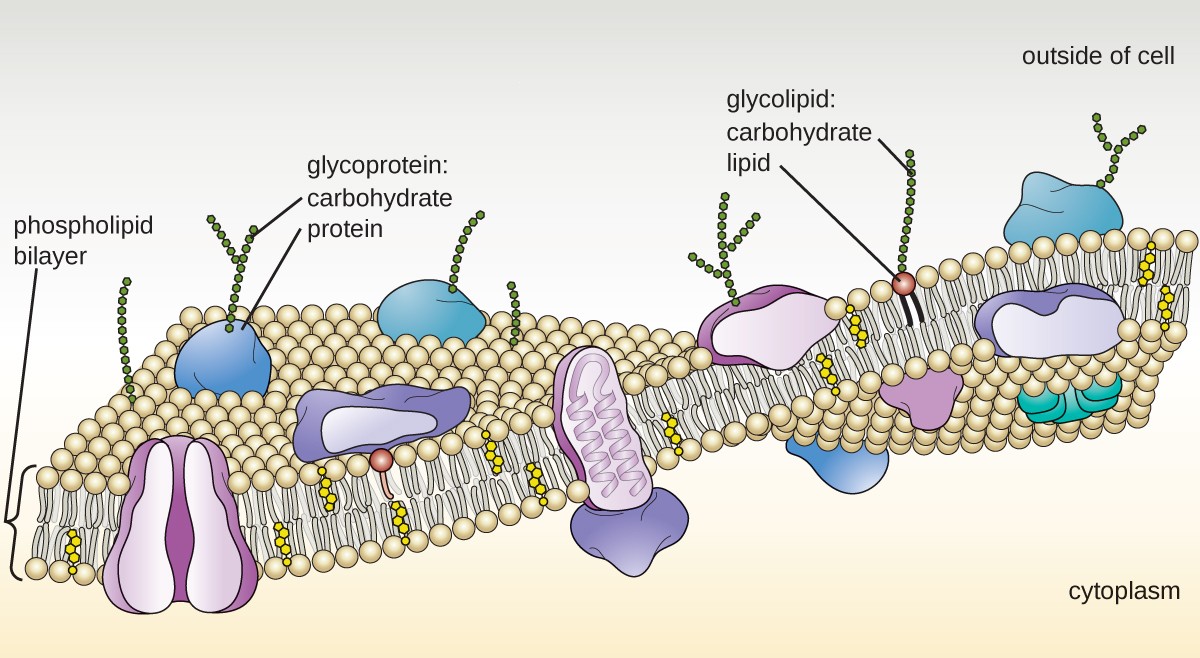 Figure 17. The eukaryotic plasma membrane is equanimous of a lipid bilayer with many embedded or associated proteins. It contains cholesterol for the maintenance of membrane, likewise as glycoproteins and glycolipids that are of import in the recognition other cells or pathogens.
Figure 17. The eukaryotic plasma membrane is equanimous of a lipid bilayer with many embedded or associated proteins. It contains cholesterol for the maintenance of membrane, likewise as glycoproteins and glycolipids that are of import in the recognition other cells or pathogens.
Membrane Transport Mechanisms
The processes of simple diffusion, facilitated diffusion, and active transport are used in both eukaryotic and prokaryotic cells. However, eukaryotic cells also accept the unique ability to perform diverse types of endocytosis, the uptake of affair through plasma membrane invagination and vacuole/vesicle formation (Figure 18). A type of endocytosis involving the engulfment of large particles through membrane invagination is called phagocytosis, which means "prison cell eating." In phagocytosis, particles (or other cells) are enclosed in a pocket within the membrane, which then pinches off from the membrane to course a vacuole that completely surrounds the particle. Another type of endocytosis is called pinocytosis, which ways "cell drinking." In pinocytosis, pocket-size, dissolved materials and liquids are taken into the prison cell through small vesicles. Saprophytic fungi, for instance, obtain their nutrients from dead and decaying matter largely through pinocytosis.
Receptor-mediated endocytosis is a type of endocytosis that is initiated by specific molecules called ligands when they bind to prison cell surface receptors on the membrane. Receptor-mediated endocytosis is the mechanism that peptide and amine-derived hormones employ to enter cells and is also used past various viruses and bacteria for entry into host cells.
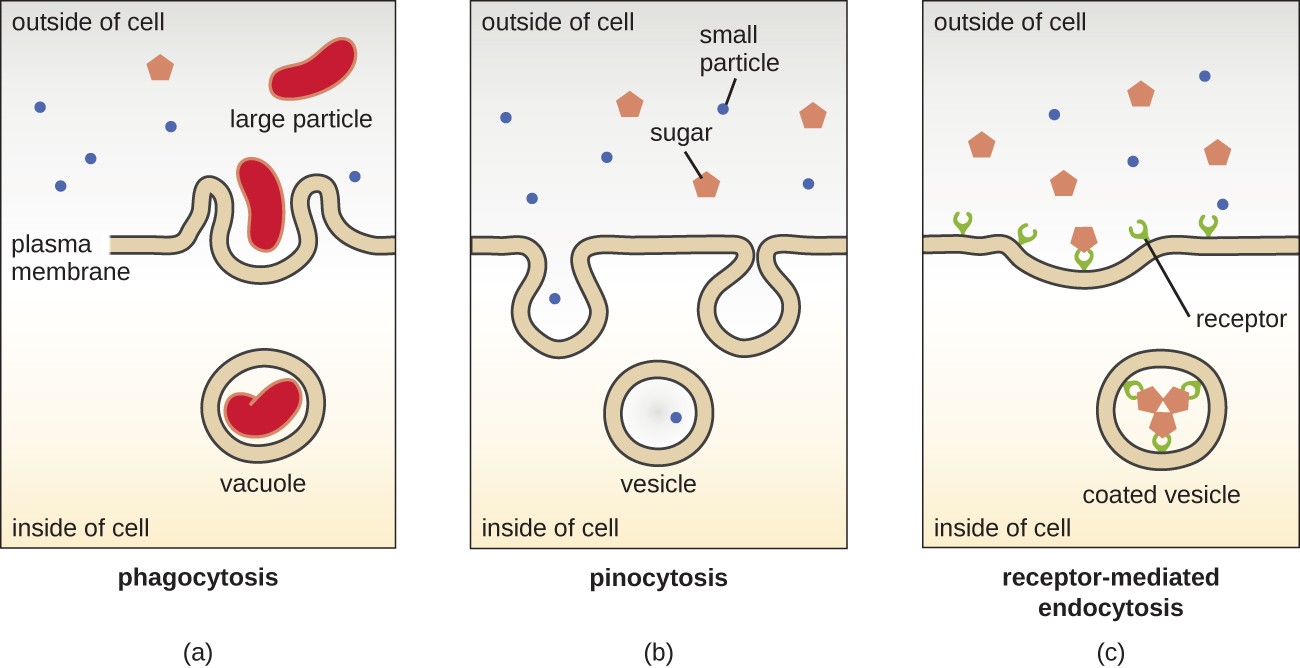 Figure 18. Three variations of endocytosis are shown. (a) In phagocytosis, the cell membrane surrounds the particle and pinches off to form an intracellular vacuole. (b) In pinocytosis, the jail cell membrane surrounds a small volume of fluid and pinches off, forming a vesicle. (c) In receptor-mediated endocytosis, the uptake of substances is targeted to a specific substance (a ligand) that binds at the receptor on the external cell membrane. (credit: modification of work by Mariana Ruiz Villarreal)
Figure 18. Three variations of endocytosis are shown. (a) In phagocytosis, the cell membrane surrounds the particle and pinches off to form an intracellular vacuole. (b) In pinocytosis, the jail cell membrane surrounds a small volume of fluid and pinches off, forming a vesicle. (c) In receptor-mediated endocytosis, the uptake of substances is targeted to a specific substance (a ligand) that binds at the receptor on the external cell membrane. (credit: modification of work by Mariana Ruiz Villarreal)
The procedure by which secretory vesicles release their contents to the cell'due south exterior is called exocytosis. Vesicles move toward the plasma membrane and then meld with the membrane, ejecting their contents out of the cell. Exocytosis is used by cells to remove waste products and may also be used to release chemical signals that can exist taken upwardly past other cells.
Prison cell Wall
In addition to a plasma membrane, some eukaryotic cells have a prison cell wall. Cells of fungi, algae, plants, and fifty-fifty some protists accept jail cell walls. Depending upon the type of eukaryotic cell, cell walls tin be made of a broad range of materials, including cellulose (fungi and plants); biogenic silica, calcium carbonate, agar, and carrageenan (protists and algae); or chitin (fungi). In general, all cell walls provide structural stability for the cell and protection from environmental stresses such every bit desiccation, changes in osmotic pressure, and traumatic injury.[12]
Extracellular Matrix
Cells of animals and some protozoans do non have cell walls to help maintain shape and provide structural stability. Instead, these types of eukaryotic cells produce an extracellular matrix for this purpose. They secrete a sticky mass of carbohydrates and proteins into the spaces between next cells (Effigy nineteen). Some protein components gather into a basement membrane to which the remaining extracellular matrix components attach. Proteoglycans typically form the bulky mass of the extracellular matrix while fibrous proteins, like collagen, provide forcefulness. Both proteoglycans and collagen are attached to fibronectin proteins, which, in turn, are attached to integrin proteins. These integrin proteins collaborate with transmembrane proteins in the plasma membranes of eukaryotic cells that lack cell walls.
In fauna cells, the extracellular matrix allows cells within tissues to withstand external stresses and transmits signals from the outside of the cell to the inside. The amount of extracellular matrix is quite extensive in various types of connective tissues, and variations in the extracellular matrix can give different types of tissues their distinct properties. In addition, a host cell's extracellular matrix is often the site where microbial pathogens attach themselves to establish infection. For example, Streptococcus pyogenes , the bacterium that causes strep throat and diverse other infections, binds to fibronectin in the extracellular matrix of the cells lining the oropharynx (upper region of the pharynx).
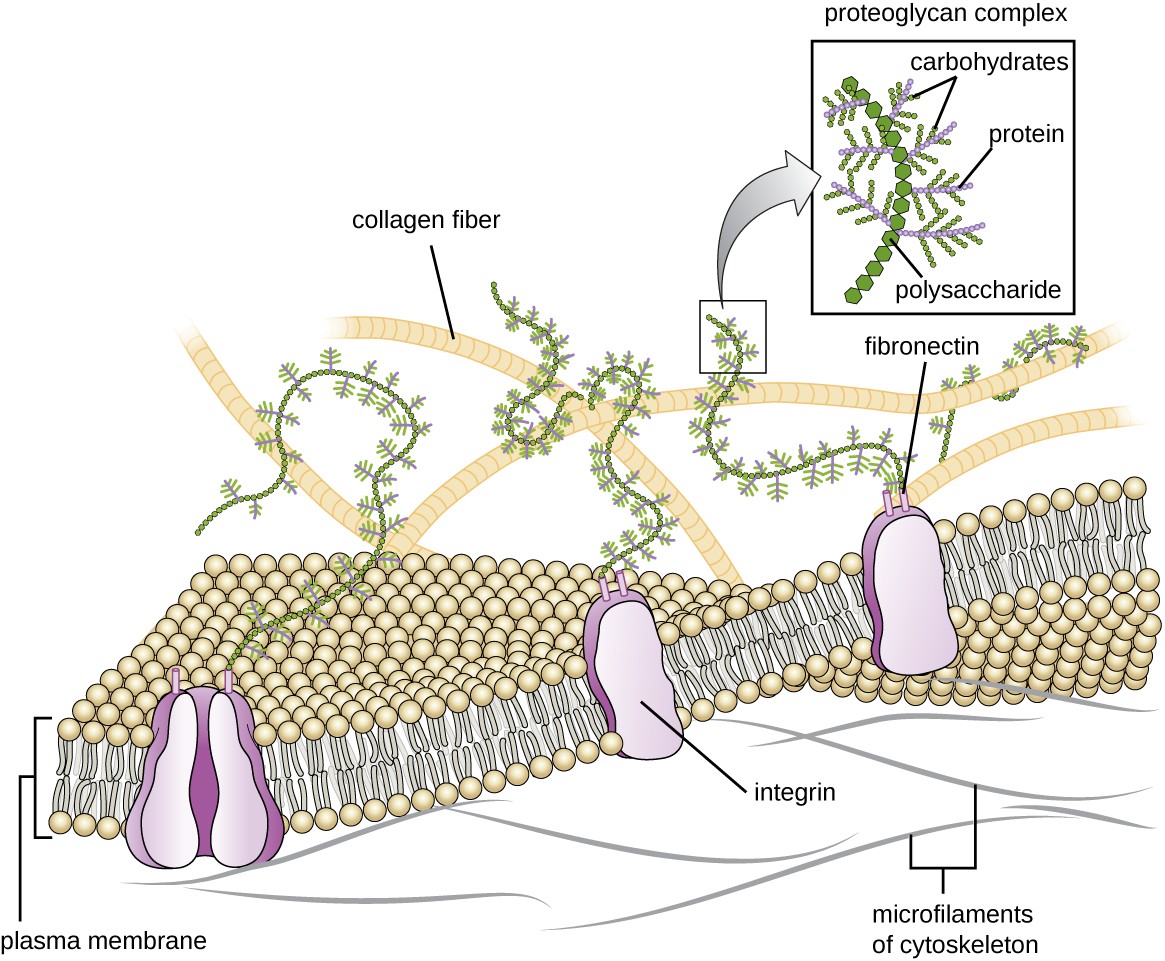 Figure 19. Click for a larger prototype. The extracellular matrix is equanimous of poly peptide and carbohydrate components. It protects cells from concrete stresses and transmits signals arriving at the outside edges of the tissue to cells deeper within the tissue.
Figure 19. Click for a larger prototype. The extracellular matrix is equanimous of poly peptide and carbohydrate components. It protects cells from concrete stresses and transmits signals arriving at the outside edges of the tissue to cells deeper within the tissue.
Flagella and Cilia
Some eukaryotic cells use flagella for locomotion; however, eukaryotic flagella are structurally distinct from those found in prokaryotic cells. Whereas the prokaryotic flagellum is a stiff, rotating structure, a eukaryotic flagellum is more like a flexible whip composed of nine parallel pairs of microtubules surrounding a key pair of microtubules. This arrangement is referred to every bit a 9+ii array (Figure 20a). The parallel microtubules use dynein motor proteins to move relative to each other, causing the flagellum to bend.
Cilia (atypical: cilium) are a like external structure found in some eukaryotic cells. Unique to eukaryotes, cilia are shorter than flagella and often cover the entire surface of a jail cell; however, they are structurally similar to flagella (a 9+2 assortment of microtubules) and use the aforementioned machinery for movement. A construction called a basal torso is establish at the base of each cilium and flagellum. The basal body, which attaches the cilium or flagellum to the cell, is composed of an array of triplet microtubules like to that of a centriole just embedded in the plasma membrane. Considering of their shorter length, cilia apply a rapid, flexible, waving movement. In addition to motility, cilia may accept other functions such as sweeping particles past or into cells. For example, ciliated protozoans utilise the sweeping of cilia to movement food particles into their mouthparts, and ciliated cells in the mammalian respiratory tract beat in synchrony to sweep mucus and debris up and out of the lungs (Effigy 20).
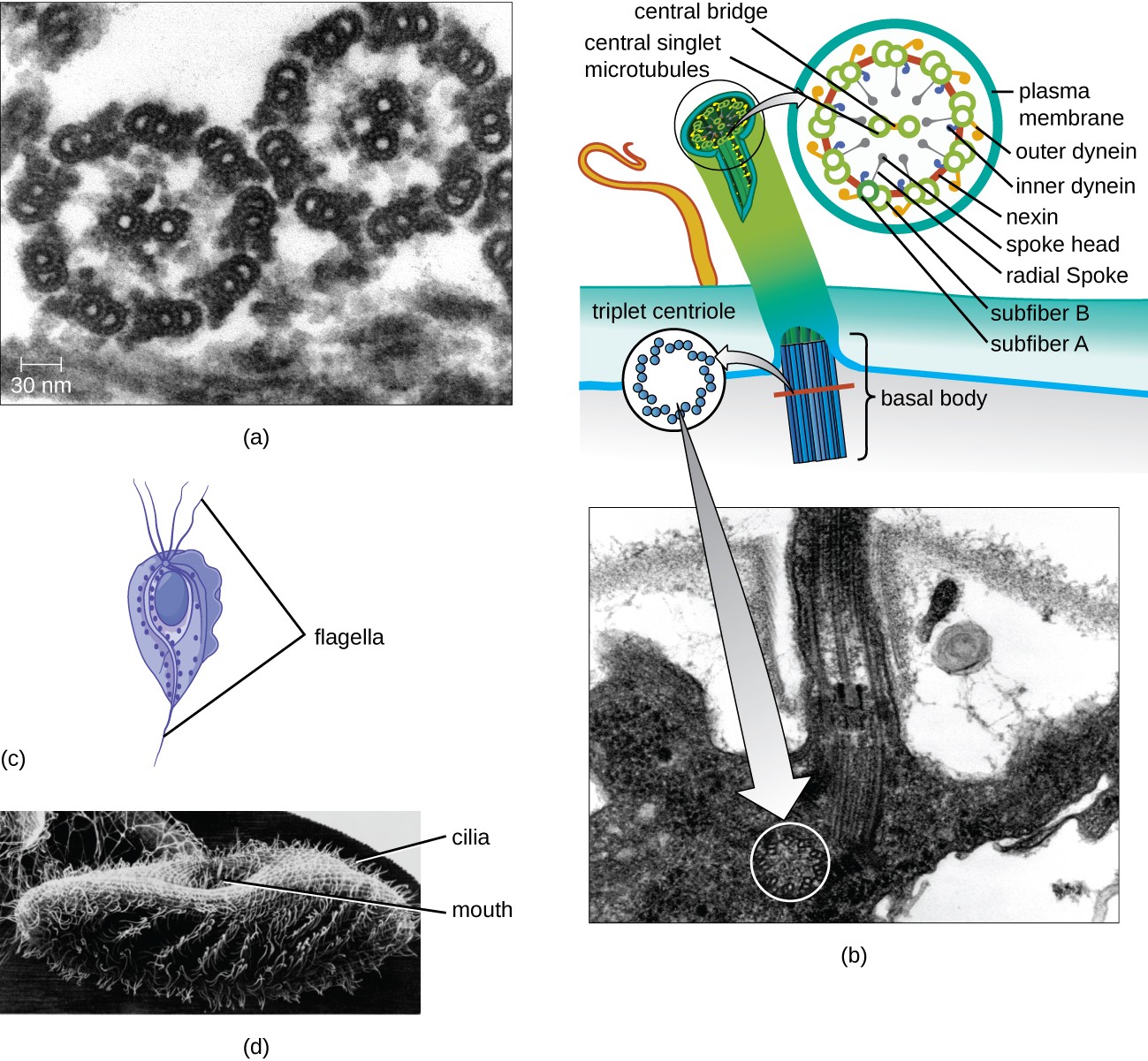 Figure xx. Click to view a larger image. (a) Eukaryotic flagella and cilia are composed of a ix+2 array of microtubules, as seen in this manual electron micrograph cantankerous-section. (b) The sliding of these microtubules relative to each other causes a flagellum to bend. (c) An analogy of Trichomonas vaginalis, a flagellated protozoan parasite that causes vaginitis. (d) Many protozoans, like this Paramecium, take numerous cilia that assistance in locomotion also as in feeding. Note the mouth opening shown here. (credit d: modification of work by University of Vermont/National Institutes of Health)
Figure xx. Click to view a larger image. (a) Eukaryotic flagella and cilia are composed of a ix+2 array of microtubules, as seen in this manual electron micrograph cantankerous-section. (b) The sliding of these microtubules relative to each other causes a flagellum to bend. (c) An analogy of Trichomonas vaginalis, a flagellated protozoan parasite that causes vaginitis. (d) Many protozoans, like this Paramecium, take numerous cilia that assistance in locomotion also as in feeding. Note the mouth opening shown here. (credit d: modification of work by University of Vermont/National Institutes of Health)
Recall about It
- Explain how the cellular envelope of eukaryotic cells compares to that of prokaryotic cells.
- Explain the departure between eukaryotic and prokaryotic flagella.
Clinical Focus: Anika, Resolution
This example concludes Anika'southward story that started in Spontaneous Generation, Foundations of Mod Cell Theory, and Unique Characteristics of Prokaryotic Cells.
Since amoxicillin has not resolved Anika's case of pneumonia, the PA prescribes another antibiotic, azithromycin, which targets bacterial ribosomes rather than peptidoglycan. After taking the azithromycin as directed, Anika'due south symptoms resolve and she finally begins to experience like herself again. Presuming no drug resistance to amoxicillin was involved, and given the effectiveness of azithromycin, the causative agent of Anika's pneumonia is most likely Mycoplasma pneumoniae . Even though this bacterium is a prokaryotic cell, information technology is not inhibited by amoxicillin considering information technology does non have a cell wall and, therefore, does not make peptidoglycan.
Key Concepts and Summary
- Eukaryotic cells are defined past the presence of a nucleus containing the DNA genome and jump by a nuclear membrane (or nuclear envelope) composed of two lipid bilayers that regulate transport of materials into and out of the nucleus through nuclear pores.
- Eukaryotic cell morphologies vary greatly and may be maintained by various structures, including the cytoskeleton, the cell membrane, and/or the cell wall
- The nucleolus, located in the nucleus of eukaryotic cells, is the site of ribosomal synthesis and the beginning stages of ribosome assembly.
- Eukaryotic cells incorporate 80S ribosomes in the rough endoplasmic reticulum (membrane bound-ribosomes) and cytoplasm (free ribosomes). They contain 70s ribosomes in mitochondria and chloroplasts.
- Eukaryotic cells have evolved an endomembrane organisation, containing membrane-spring organelles involved in ship. These include vesicles, the endoplasmic reticulum, and the Golgi appliance.
- The smooth endoplasmic reticulum plays a role in lipid biosynthesis, sugar metabolism, and detoxification of toxic compounds. The rough endoplasmic reticulum contains membrane-bound 80S ribosomes that synthesize proteins destined for the cell membrane
- The Golgi apparatus processes proteins and lipids, typically through the improver of sugar molecules, producing glycoproteins or glycolipids, components of the plasma membrane that are used in cell-to-cell communication.
- Lysosomes contain digestive enzymes that break down modest particles ingested past endocytosis, large particles or cells ingested by phagocytosis, and damaged intracellular components.
- The cytoskeleton, equanimous of microfilaments, intermediate filaments, and microtubules, provides structural support in eukaryotic cells and serves equally a network for ship of intracellular materials.
- Centrosomes are microtubule-organizing centers important in the formation of the mitotic spindle in mitosis.
- Mitochondria are the site of cellular respiration. They have two membranes: an outer membrane and an inner membrane with cristae. The mitochondrial matrix, within the inner membrane, contains the mitochondrial DNA, 70S ribosomes, and metabolic enzymes.
- The plasma membrane of eukaryotic cells is structurally similar to that establish in prokaryotic cells, and membrane components motion co-ordinate to the fluid mosaic model. However, eukaryotic membranes comprise sterols, which alter membrane fluidity, too equally glycoproteins and glycolipids, which help the prison cell recognize other cells and infectious particles.
- In addition to active transport and passive ship, eukaryotic cell membranes can take material into the cell via endocytosis, or expel matter from the jail cell via exocytosis.
- Cells of fungi, algae, plants, and some protists have a prison cell wall, whereas cells of animals and some protozoans have a gluey extracellular matrix that provides structural back up and mediates cellular signaling.
- Eukaryotic flagella are structurally distinct from prokaryotic flagella only serve a similar purpose (locomotion). Cilia are structurally similar to eukaryotic flagella, simply shorter; they may exist used for locomotion, feeding, or motion of extracellular particles.
Multiple Pick
Which of the following organelles is non role of the endomembrane system?
- endoplasmic reticulum
- Golgi apparatus
- lysosome
- peroxisome
Show Reply
Answer d. Peroxisomes are not office of the endomembrane system.
Which blazon of cytoskeletal cobweb is important in the germination of the nuclear lamina?
- microfilaments
- intermediate filaments
- microtubules
- fibronectin
Show Answer
Answer b. Intermediate filaments are important in the formation of the nuclear lamina.
Sugar groups may exist added to proteins in which of the following?
- smooth endoplasmic reticulum
- rough endoplasmic reticulum
- Golgi apparatus
- lysosome
Evidence Answer
Answer c. Sugar groups may be added to proteins in the Golgi apparatus.
Which of the post-obit structures of a eukaryotic prison cell is non probable derived from endosymbiotic bacterium?
- mitochondrial Dna
- mitochondrial ribosomes
- inner membrane
- outer membrane
Prove Respond
Answer d. The outer membrane is not probable derived from endosymbiotic bacterium.
Which type of nutrient uptake involves the engulfment of small dissolved molecules into vesicles?
- active ship
- pinocytosis
- receptor-mediated endocytosis
- facilitated diffusion
Show Answer
Answer b. Pinocytosis involves the engulfment of small dissolved molecules into vesicles.
Which of the following is non equanimous of microtubules?
- desmosomes
- centrioles
- eukaryotic flagella
- eukaryotic cilia
Show Answer
Answer a. Desmosomes are non composed of microtubules.
Truthful/False
Mitochondria in eukaryotic cells contain ribosomes that are structurally similar to those found in prokaryotic cells.
Show Answer
Truthful
Fill in the Bare
Peroxisomes typically produce _____________, a harsh chemical that helps intermission downwardly molecules.
Prove Answer
Peroxisomes typically produce hydrogen peroxide, a harsh chemical that helps suspension downwards molecules.
Microfilaments are composed of _____________ monomers.
Bear witness Answer
Microfilaments are composed of actin monomers.
Recollect virtually It
- What existing prove supports the theory that mitochondria are of prokaryotic origin?
- Why do eukaryotic cells require an endomembrane organisation?
- Name at to the lowest degree ii ways that prokaryotic flagella are different from eukaryotic flagella.
- How are peroxisomes more similar mitochondria than similar the membrane-jump organelles of the endomembrane system? How do they differ from mitochondria?
- Why must the functions of both lysosomes and peroxisomes exist compartmentalized?
- Characterization the lettered parts of this eukaryotic cell.
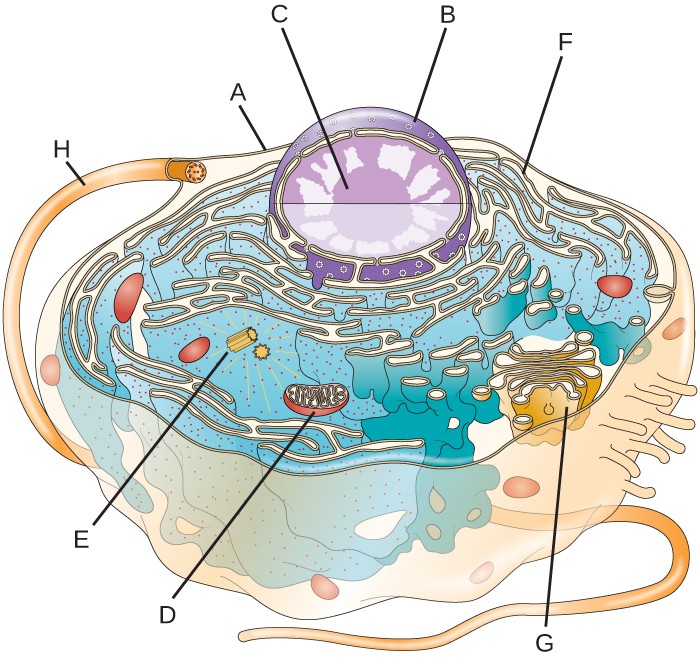
Licenses and Attributions
Source: https://courses.lumenlearning.com/microbiology/chapter/unique-characteristics-of-eukaryotic-cells/
Posted by: petersonquilichich.blogspot.com

0 Response to "Are Animal And Plant Cells Eukaryotic Or Prokaryotic"
Post a Comment